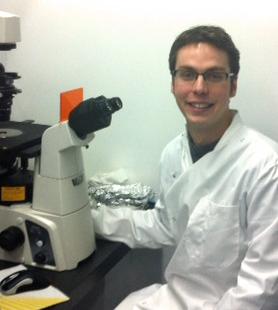
Ganley lab uncovers a role for iron in mitochondrial turnover
Mitochondria are the powerhouses of the cell as they supply most of the fuel, known as ATP, that drives essential chemical reactions. They also perform many other important functions involved in metabolism, signalling, development and cell death. Given their important role, it comes as no surprise that mitochondrial dysfunction has been linked to many diseases including cancer and neurodegeneration. Faulty mitochondria are thought to be major cellular polluters as they release toxic reactive oxygen species; therefore it is vital to remove such mitochondria before they can cause cellular damage. One mechanism by which mitochondria are degraded and recycled is through the autophagy pathway.
Very little is known about the specifics of mitochondrial turnover by autophagy (mitophagy), so George Allen, a postdoc in Ian Ganley's lab, developed a novel assay to aid in studying this process. The assay is very simple, yet very powerful as it allows rapid measurement of the level of mitophagy occurring in a cell. Mitochondria are tagged with green and red fluorescent dyes, such that both fluoresce under the microscope under normal conditions. However, when mitochondria undergo mitophagy they are delivered to the lysosome, where the acidity quenches the green signal, but not the red. Therefore the number of mitochondria can be assessed by total fluorescence and the degree of mitophagy calculated by the increase in the red:green fluorescent ratio. Using this assay, George discovered that loss of iron from the cell strongly stimulated mitophagy and he is now trying to identify the precise signals that trigger this event.
Many neurological disorders, such as Parkinson's, are believed to arise at least in part, from mitochondrial dysfunction. It is also interesting to note that iron often accumulates in the brains of these patients. Given this, the Ganley Lab hopes that this work will be important in developing new therapies for conditions where mitochondrial clearance would be advantageous. This work has just been published in
Very little is known about the specifics of mitochondrial turnover by autophagy (mitophagy), so George Allen, a postdoc in Ian Ganley's lab, developed a novel assay to aid in studying this process. The assay is very simple, yet very powerful as it allows rapid measurement of the level of mitophagy occurring in a cell. Mitochondria are tagged with green and red fluorescent dyes, such that both fluoresce under the microscope under normal conditions. However, when mitochondria undergo mitophagy they are delivered to the lysosome, where the acidity quenches the green signal, but not the red. Therefore the number of mitochondria can be assessed by total fluorescence and the degree of mitophagy calculated by the increase in the red:green fluorescent ratio. Using this assay, George discovered that loss of iron from the cell strongly stimulated mitophagy and he is now trying to identify the precise signals that trigger this event.
Many neurological disorders, such as Parkinson's, are believed to arise at least in part, from mitochondrial dysfunction. It is also interesting to note that iron often accumulates in the brains of these patients. Given this, the Ganley Lab hopes that this work will be important in developing new therapies for conditions where mitochondrial clearance would be advantageous. This work has just been published in

